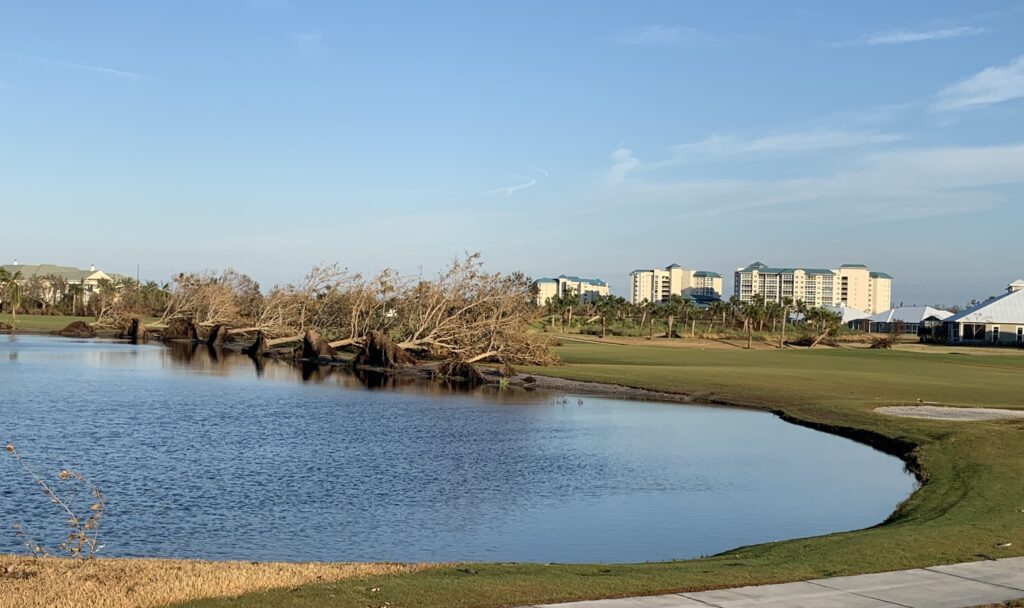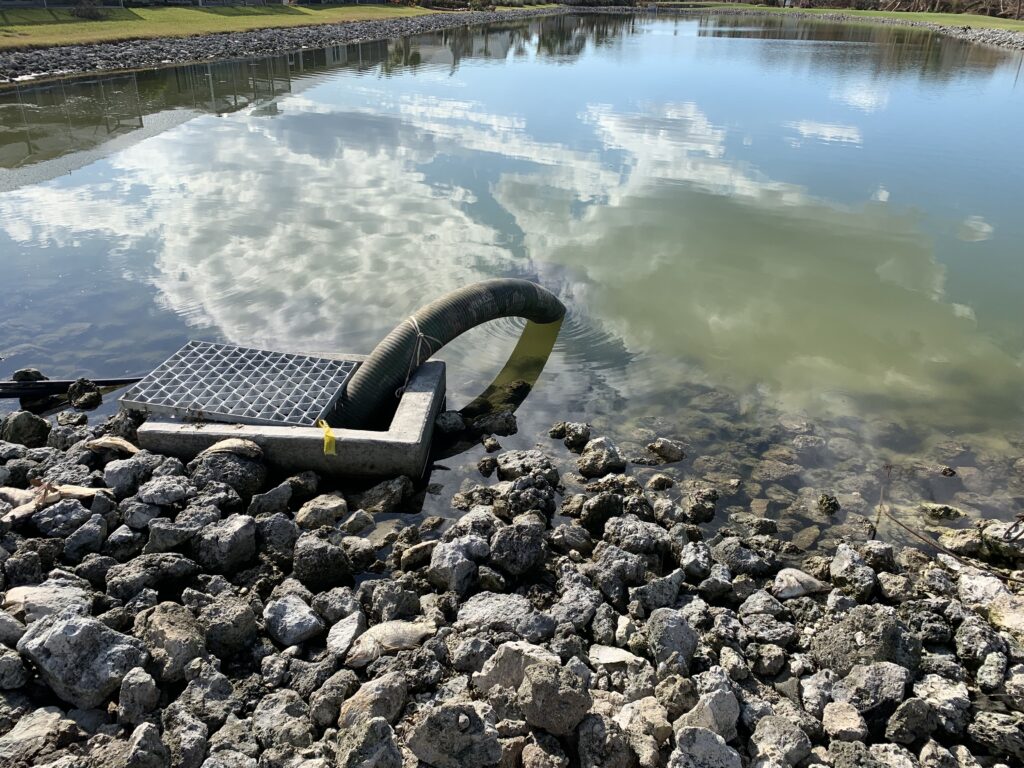Platinum TE at Shell Point Golf Club Survives Hurricane Ian
Among the many obstacles that a golf course superintendent faces year in and year out, natural disasters are perhaps the most feared. The unpredictability and catastrophic effects have no regard for well-laid maintenance plans and faithfully executed preventative routines. Superintendent Brant Dittmer of Shell Point Golf Club found himself in Mother Nature’s path when Hurricane Ian tore through southwest Florida last September, making landfall less than 30 miles away. While the damage was extensive, the silver lining Dittmer discovered was that his turfgrass could weather the storm.
Shell Point Golf Club
Dittmer came to Shell Point Golf Club five years before Hurricane Ian. Located between Sanibel Island and Fort Myers Beach, Florida, the golf course is the centerpiece of Shell Point Retirement Community.
“The focus here is on long-term health and wellness, and golf is a big part,” said Dittmer. “Having a golf course is what sets us apart from other retirement communities.”

When Dittmer arrived, the 18-hole championship course designed by Gordon Lewis was a combination of bermudagrass and paspalum. In 2013, before Dittmer came, the club converted its collars and greens from bermuda to Platinum TE® Paspalum. Managing the two species side-by-side, Dittmer quickly discovered that the high salt content irrigation water pulled from wells and the poor soil conditions at Shell Point did not suit the bermudagrass fairways and roughs.
“Typically, when our salt got high, the bermudagrass would turn off-color to a yellowish shade,” said Dittmer. “The bermuda would decline significantly during months of cooler temperatures and shorter days. These conditions, along with higher salt and alkaline soil, did not create a good environment for the bermudagrass.”
Conversion to Platinum TE
Although not a Florida native, Dittmer had spent the previous decade at golf courses in the state, including The Club at Mediterra, Bonita Bay Club, and The Club at Gateway. None of those courses had paspalum during his time at each, so Shell Point was Dittmer’s first exposure to the species.
“I could see right away that the paspalum was outperforming the bermuda,” said Dittmer. “Whereas the paspalum may not love the conditions of our soil and water, it continues to grow. That’s where I feel that paspalum really sets itself apart during times when growth is not optimal, like during cold snaps or when sodium comes up in the irrigation water. We’re still mowing the Platinum TE and seeing consistent growth.”
I could see right away that the paspalum was outperforming the bermuda.
Brant Dittmer, Superintendent of Shell Point Golf Club
Amidst these circumstances, Dittmer had no problem standing behind the decision to convert the remainder of the course to Platinum TE.
“It was a no brainer,” said Dittmer. “It outcompeted the bermudagrass. We had areas struggling in bermuda and areas thriving in paspalum. We know paspalum was the way to go.”
In 2018, Shell Point converted the front nine holes and the driving range tee to Platinum TE, and in 2019, they followed with the back nine and the driving range fairway.
“Now everything is Platinum TE. All 18 holes tee-to-green.”
Performing Above and Beyond
In the years between the turfgrass conversion and the hurricane, Platinum TE lived up to Dittmer’s expectations.
“It was performing great,” said Dittmer. “Before the hurricane, we had solid years of growth with very little disease and very few weeds. The color was awesome, and the Platinum TE could withstand our traffic.”
In the year before the hurricane, Shell Point saw 36,000 rounds. And before that, during the height of Covid, wear on the golf course was amplified by single-rider golf cart traffic.
“Platinum TE really proved its high tolerance for traffic and wear,” said Dittmer. “In the areas where our cart traffic goes off the path, the grass did not decline. It didn’t grow as fast as before, but there was no decline in the turfgrass quality at all.”
Then Came the Hurricane
On September 28, 2022, Hurricane Ian hit Florida after making landfall in Cuba. At its strongest point over the Gulf of Mexico, Ian reached Category 5 levels and arrived in the U.S. just below peak intensity. The storm produced surges up to eight feet and caused severe flood damage. On the golf course, an 80-foot bridge was lifted from its location on hole six and set down some 100 yards away.
But as concerned as he was for the golf course, Dittmer gave his first attention to the residents at Shell Point.


“The primary focus was to get the residents out of the storm shelter and back into their homes,” said Dittmer. “We cleared the roads and paths for the community first. It was a couple of days before we could even address the course.”
The Aftermath
What Dittmer found when he was able to turn his attention to the golf course was shocking. Their entire irrigation system was out, with nearly every irrigation satellite control box destroyed. Salt water filled their irrigation lake. Every green but one had been submerged in ocean water. Hundreds of trees on the golf course were down. And they were without power for five days.
“We had no power, no irrigation system, and by the time I could get out there, there was still standing water on the course. The irrigation pump house was submerged, and our main electrical panel was submerged in water, too,” said Dittmer. “Fortunately, inside the maintenance shop, we only got six inches of surge. We did not lose many pieces of equipment; what was lost was parked in other places on campus.”


Dittmer and his team immediately tackled their water issue. Using submersible pumps and generators, they pumped down their irrigation lake into another and refilled using artesian flow.
Before restoring running water, Dittmer used sprayers to irrigate the greens with what little water they could get from the tap. However, multiple breaks in the city water resulted in very low pressure.
“Eventually, we got a pump hooked up to our pump house,” said Dittmer. “We could water about six irrigation heads at a time, but they had to be running all the time because we had no pressure release valve. We still didn’t have power to the field, so the team had to go around with flag keys turning on heads and then turning them off.”
The process of restoring irrigation came in three phases with the first being the manual task of using flag keys. The staff then operated irrigation through generator power for two months. Following that, bypass was established to a temporary breaker panel.
Turfgrass Recovery
Even though the storm surge did not last long, ocean water covered the golf course entirely and remained in some low-lying areas for longer.
“The sodium just came in and saturated the soil profile,” said Dittmer. “But even right away, the greens looked all right. You couldn’t really tell they had been submerged. I had three greens that suffered the most damage due to how low they sat. These were lower than the surrounding area – kind of bowl-shaped. So they were saturated for a while there with ocean water sitting on them.”
However, all of the greens survived.
“I reached out to Dr. Duncan to make sure everything we were doing was correct,” Dittmer said, referring to Dr. Ron Duncan, the developer of Platinum TE and renowned turfgrass scientist.
“He said we were going about it the right way. It was very refreshing to hear him say that our grass would be just fine – that we have the right grass for this situation. I was mainly worried about the water quality going onto the turf. Were we going to burn it? He said you cannot burn this turf. The ocean water was not good for it, but it won’t burn it.”
Dittmer was pleased to see that Dr. Duncan was correct, as the turfgrass rebounded almost immediately.
The course greened up pretty quickly after the storm. It never really went off-color except for the three greens for a short time. The rest of the course retained color and hardly showed any damage.
Brant Dittmer, Superintendent of Shell Point Golf Club
“The course greened up pretty quickly after the storm. It never really went off-color except for the three greens for a short time. The rest of the course retained color and hardly showed any damage.”
What could have been a devastating loss with a less salt-tolerant turfgrass became a success story for Shell Point and Platinum TE. While Dittmer was concerned about the effects the saltwater surge could have on the turf, the resilience of Platinum TE, his diligence in getting the systems operational again, and some well-timed rainfall led to a speedy recovery and a remarkably quick reopening.

Back in Business
For the short time that the course was closed, Dittmer went without mowing for about four weeks.
“We didn’t do a whole lot of mowing. We stayed off as much as possible to get the greens to rebound – especially the three that had the most ocean water. After repeat run cycles, we had a good turnaround with green-up just staying off the greens.”
The break didn’t last for long, however. Two weeks after mowing resumed so did play. Approximately six weeks after Hurricane Ian, Shell Point opened nine holes. The entire course reopened less than two weeks later – just before Thanksgiving.
I don’t think Shell Point would have recovered nearly as fast without Platinum TE.
Brant Dittmer, Superintendent of Shell Point Golf Club
Dittmer admits that the facility does not look as it did before, with extensive damage to parts of Shell Point other than the golf course turfgrass.
“We lost a lot of landscape due to the surge,” said Dittmer. “The wind and the salt burned up most of the shrubs around here, and we lost a couple of hundred trees on the golf course alone. But we kept the grass green. The golf course is a little oasis of green because everything else around it is brown from the storm.”
The surrounding courses did not rebound as quickly, with Shell Point being the first in the area to reopen, prompting others to take a close look at Platinum TE.
“We’re allowing other golf courses to utilize our facilities. With other memberships playing here, they are seeing the performance of our turf,” said Dittmer. “I don’t think Shell Point would have recovered nearly as fast without Platinum TE.”
Platinum TE is definitely the right turf for our environment.
Brant Dittmer, Superintendent of Shell Point Golf Club
Today at Shell Point
After reopening and the extra traffic that came with additional golfers, Dittmer admitted to having some concerns.
“I was a little worried going into the season [Thanksgiving through Easter] that maybe the turf would get easily stressed, but no. I thought we might have some disease issues, but we have not. The turf is strong and has held up even through the recent drought. It’s going well. Even during the shortest days of the year, the course held up. The color has been spot-on ever since. Platinum TE is definitely the right turf for our environment.”

